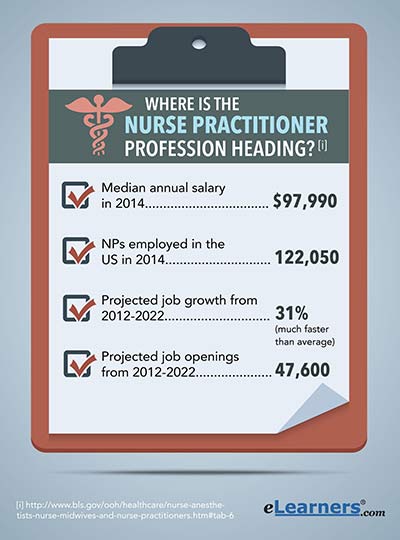What is a Nurse Practitioner?
by Jill Kapinus
 As the healthcare industry continues to undergo rapid change, the demand for nurses is expected to surge within the coming years. An increased emphasis on preventative care and the aging of the baby boom generation are a few of the factors driving this growth.[i] So if you want to enter a field where you can enjoy the gratification that comes with helping people maintain good health, becoming a nurse practitioner may be the right path to pursue.
As the healthcare industry continues to undergo rapid change, the demand for nurses is expected to surge within the coming years. An increased emphasis on preventative care and the aging of the baby boom generation are a few of the factors driving this growth.[i] So if you want to enter a field where you can enjoy the gratification that comes with helping people maintain good health, becoming a nurse practitioner may be the right path to pursue.
But what exactly is a nurse practitioner? In short, nurse practitioners occupy a more advanced level of nursing than the typical registered nurse -- hence they are also known as advanced practice registered nurses, or APRNs. Though the scope of their responsibilities may vary from state to state, a common denominator among nurse practitioners is the training and education needed to provide and coordinate both primary and specialty health care. Responsibilities may include prescribing medication, conducting physical exams, and performing diagnostic tests like lab work and x-rays.
Below are a few answers to some questions you may have if you’re considering pursuing a career as a nurse practitioner.
What are Nurse Practitioner Requirements?[ii]
Pursuing a career as a nurse practitioner takes hard work and dedication. Be prepared to cover these core requirements:
- Master’s degree in nursing
- A license to practice nursing in the state of employment
- Successful completion of the national certification exam
How Much Could Nurse Practitioners Earn?[ii]
Here are a few stats to keep in mind from the Bureau of Labor:
- Median annual salary for 2014: $97,990
- Nurse practitioners employed in America in 2014: 122,050
- Projected job growth from 2012-2022: 31% (much faster than average)
- Projected job openings from 2012-2022: 47,600
Which Industries Have the Greatest Concentration of Nurse Practitioners?[iii]
Here are statistics that shed light on the healthcare settings and facilities where nurse practitioners are most likely to work.
- Offices of physicians: 57,100
- General medical and surgical hospitals: 32,310
- Outpatient care centers: 9,390
- Colleges, universities, and professional schools: 3,570
- Home health care services: 3,090
Which States Have the Highest Employment Level for Nurse Practitioners?[iii]
If you’re wondering which states might have the highest levels of employment in the field, here are the top 5 states with the most nurse practitioners.
- New York: 10,310
- California: 9,980
- Texas: 7,260
- Florida: 6,990
- Massachusetts: 5,080
Nurse Practitioner Specialties
- Pediatric nurse practitioner specializes in the care of infants, children, and teens.
- Neonatal nurse practitioner serves as a caregiving specialist for premature babies and other newborns suffering from illnesses and abnormalities.
- Family nurse practitioner provides basic care for family members at various life stages.
- Acute care nurse practitioner provides specialized care to adults suffering from serious health conditions.
Nurse Practitioner Programs Online
If the idea of pursuing a nurse practitioner education is appealing to you, but you need an online degree option that will give you the flexibility to meet the nurse practitioner requirements on your own schedule, you’re in luck. Pursuing a career as a nurse practitioner may seem like a daunting proposition given your busy life. But the fact is, there are plenty of convenient nurse practitioner programs online that enable you to earn your degree at your own pace, without having to rush off to a classroom or rearrange your life around a campus schedule. To explore nurse practitioner specialties and find your perfect degree program, use our quick and easy degree finder.
[i] bls.gov/ooh/healthcare/nurse-anesthetists-nurse-midwives-and-nurse-practitioners.htm#tab-6 | [ii] bls.gov/ooh/healthcare/nurse-anesthetists-nurse-midwives-and-nurse-practitioners.htm | [iii] bls.gov/oes/current/oes291171.htm
